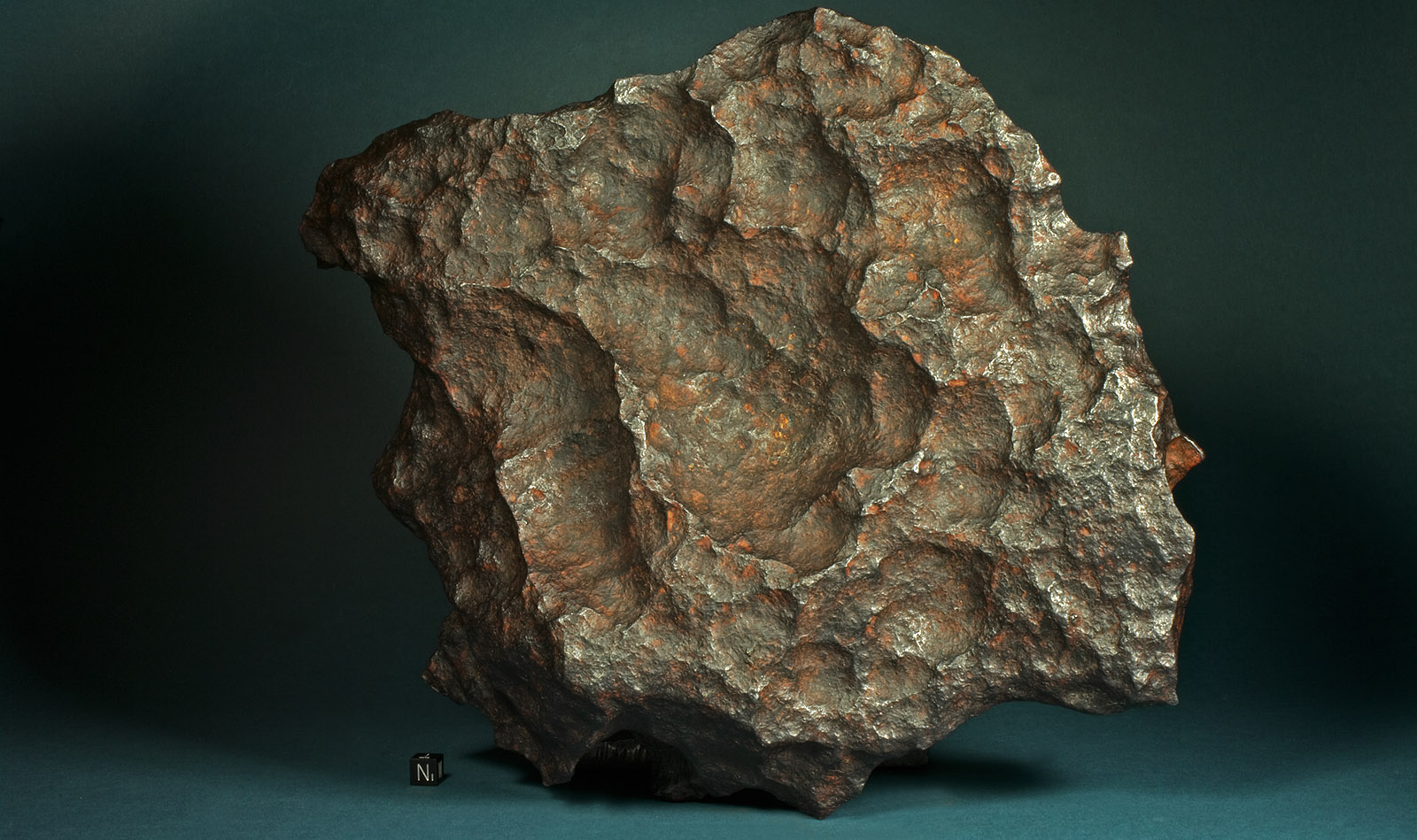Long before modern man cast his eyes on the fierce cliffs and the rolling hills of the Great Namaquas, a celestial spectacle unequalled in modern times occurred over the Kalahari and South African sky. From the icy depths of space a solid rock of iron measuring roughly 4 x 4 x 3 meters entered the atmosphere of our planet at a low angle of 10° to 20° along a northwesterly trajectory. While still in the upper atmosphere the accumulating drag forces tore the body apart and the meteoroid fragmented in a terminal explosion which rocked the country for hundreds of miles. Dragging fiery trails behind them the fragments and shreds of the cosmic intruder continued their rapid descent. In the plasma jet stream their outer surfaces melted and while the liquid melts were continuously stripped off by the gas stream uneven masses with deep cavities formed. When the iron meteorites hit the savannahs around a then nameless extinct volcano today known as the Brukarros structure, thunder from the terminal explosion rolled across the canyons and plains.
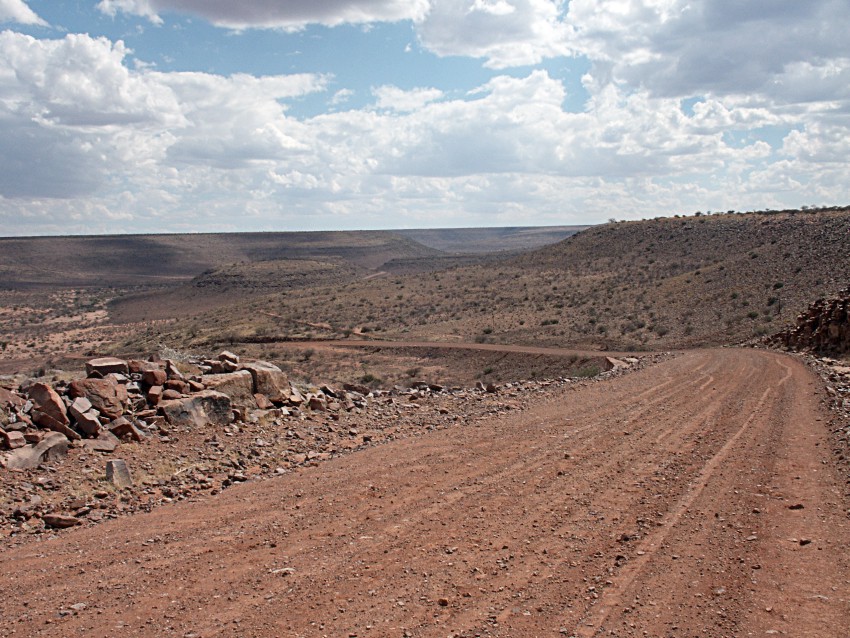
District road no. 1089 from Gibeon to Helmeringhausen: view towards Schwarzrand Mountains and Hardap region which provides a good example of the terrain conditions in the western part of the Gibeon strewn field. Image courtesy of Dr.-Ing. Klaus Dierks
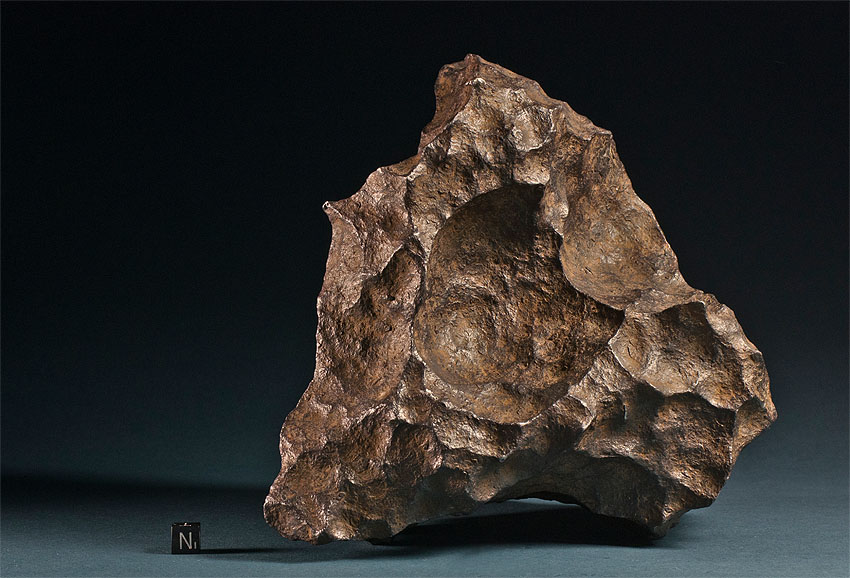
Sculpted Gibeon individual with distinct regmaglypts, 11.6 kg
Discovery
Subsequently to his South African journey of almost four thousand miles, James Edward Alexander; Captain in the British and Lieutenant-Colonel in the Portuguese Service, in 1838 published a two volume work with the appropriate title “An Expedition Of Discovery Into The Interior of Africa, Through The Hitherto Undescribed Countries Of The Great Namaquas, Boschmans, And Hill Damaras. Performed Under The Auspices Of Her Majesty’s Government, And The Royal Geographical Society”.
Capt. (later General, Sir) J. E. Alexander was not the first to travel up the Great Fish River. Several Dutch colonists, among them W. Van Reenen, went northwards along the river before 1836, but their accounts were never published. What makes Alexander’s account interesting to us is his mentioning of several specimens of native iron on the east bank of the Great Fish River. Alexander never examined these masses with his own eyes but he was able to obtain a sample which proved the claims of his scouts. Alexander submitted the sample to Sir John Herschel, who then was president of the Literary and Scientific Institution of South Africa.
Herschel undertook a chemical examination of the iron and Alexander provided the resulting description in the appendix on “Mineral Specimens” on p. 272 of vol. 2 of his work. It is the first written description of a meteorite specimen from what would later become the largest known strewn field of extraterrestrial bodies on earth:
“The specimen in question weighed 21.79 grains; 3.12 of which were separated, and submitted to a hasty preliminary examination for the detection of nickel, if any, but the quantity proving to small, the whole of the remainder was operated on in a subsequent trial. The iron was highly malleable and tenacious, and apparently of excellent quality, with a somewhat whiter and more silvery lustre than belongs to the metal in its ordinary state, and apparently little liable to oxidation, qualities which are observed in iron, of what is usually considered undoubted meteoritic origin.”
Herschel continued with the description of his analysis technique as described in his articles in the “Annalen der Chemie” (1833) and “Philosophical Transactions (1821) and which determined a nickel proportion of 4.61 percent for the sample. Herschel concludes: “Thus it appears that the specimen brought home by Capt. Alexander, has equal claim to a meteoritic origin with any of those masses of native nickeliferous iron which have been found in different localities, and to which that origin has, without other evidence, been attributed.”
What followed was the first recognition of the fact that the Gibeon masses constitute a strewn field:
“All those specimens, however, have, so far as I know, been insulated single masses. But what constitutes the peculiar and important feature of the discovery of Capt. Alexander, is the fact stated by him of the occurrence of masses of this native iron in abundance, scattered over a considerable tract of country. If a meteoritic origin be attributed to all these, a shower of iron must have fallen, and as we can imagine no cause for the explosion of a mass of iron, and can hardly conceive a force capable of rending into fragments, a cold block of this very tenacious material, we must of necessity conclude it had to arrive in a state of fusion, and been scattered around by the assistance of the air or otherwise, in a melted, or at least softened state.”
Shepard and the Lion River iron
The next important chapter in the history of the Gibeon iron meteorite was opened in 1853 with the publication of Charles Upham Shepard’s Notice of Lion River, South Africa, Meteoritic Iron. In his work Shepard described the circumstances of the discovery of a 178 lbs mass of meteoritic iron on a clay plain near the Lion River and its subsequent transport by Mr. John Gibbs via ox cart to Cape Town. The meteoritic iron was shipped to London where it was purchased by mineralogist to Queen Victoria, Professor John Tennant, who forwarded it via New York to Professor Charles Shepard of Amherst College in Massachusetts.
Shortly after the meteorite arrived at Amherst College Shepard performed several experiments, determined the Ni content and etched two cut surfaces. Apparently the Lion river mass was the first intact Gibeon meteorite ever, that was scientifically analyzed in the US. Concerning the cut marks on this specimen Shepard quoted the notes of John Gibbs: “The part cut has been done by the Namaquas for fabricating arrow-heads and assagais; the traces of two or three abortive attempts of cutting may also be seen on the surface of the mass.”
Additionally Shepard was the first to comment on the find situation of a Gibeon meteorite which was found on the spot where it fell. He described the clay layer, of which he had received samples, as a “compact and hard marl, penetrated by seams of iron-pyrites, which appear to fill spaces once occupied by fossil shells.
It may be presumed therefore, that it belongs to the tertiary series in geology; and inasmuch as the iron mass presents a perfectly clean, and nearly an unoxidated surface, it is possible that its fall has either been very recent, or that is has until lately been imbedded in this formation, and thus preserved from rusting.”
Brezina, Cohen, Berwerth and the Mukerop iron
In 1902 Aristides Brezina and Emil Cohen gave an extensive description of a 178 kg meteorite which was found in 1899 near Mukerop (Mukorob). After a cast was prepared the meteorite was cut under supervision of Prof. Fraas into a middle section of 16 kg, and two end blocks of 86 and 61 kg respectively. The cut loss was 15 kg. The 16 kg midsection went to the Naturalienkabinett in Stuttgart and onto the tables of the leading contemporary experts on iron meteorites Emil Cohen and Aristides Brezina. Quickly they arrived at the conclusion that the meteoritic iron was paired with the Lion River mass.
After etching the specimen, Brezina noticed that about a third of the cut section produced only a very week Widmanstätten pattern, a fact that he attributed to the thinness of the taenite lamellae and to the homogeneity of the kamazite in this part of the meteorite. As an explanation Brezina and Cohen suggested a slow reheating of the mother body subsequent to its formation and cooling.
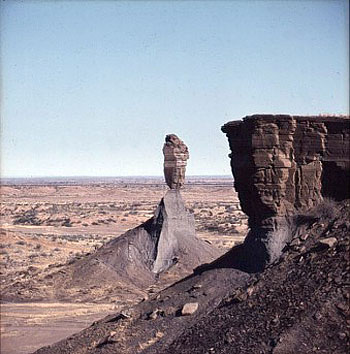
The “Mukorob” (“God’s Finger”) land mark, which gave name to the 178 kg Mukerop mass found within sight of the rock formation. The photo was taken several days before December 4, 1988, when the rock collapsed. This happened shortly before the Namibian independency in 1989. According to an old Nama legend the rule of the white man would come to end when the rock falls. Image courtesy of Dr.-Ing. Klaus Dierks
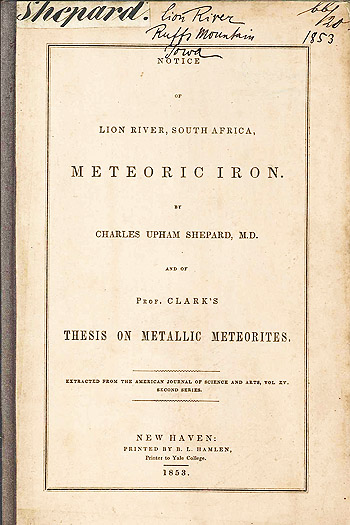
Shepard’s 1853 Notice of Lion River, South Africa, Meteoritic Iron
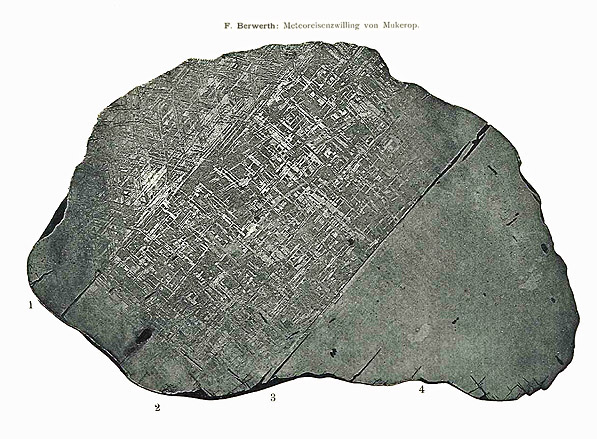
The photomacrograph of a Gibeon cut section provided in Berwerth’s analysis of the Mukerop iron
As accessory parts, the authors describe schreibersite, troilite and graphite. The nickel content is given with 8.19 percent. In providing a synopsis of their chemical analysis with those of the iron meteorites of Bethany, Lion River and Mukerop they concluded that all three finds are paired. In the same year as Cohen and Brezina, Friedrich Berwerth (1902) from the Museum of Natural History in Vienna, published a metallurgical analysis of a Gibeon slice with the dimensions 43 x 31 cm that was also cut from the 178 kg mass examined in the Naturalienkabinett in Stuttgart. Berwerth provided a photograph of this slice and his analysis resulted in the first discovery of enstatite in the Gibeon meteorite.
continue



